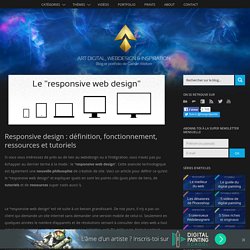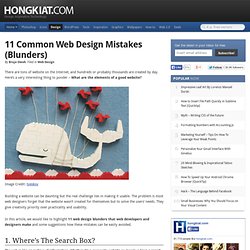

Responsive design : définition, fonctionnement, ressources et tutoriels. Si vous vous intéressez de près ou de loin au webdesign ou à l’intégration, vous n’avez pas pu échapper au dernier terme à la mode : le “responsive web design”.

Cette avancée technologique est également une nouvelle philosophie de création de site. Voici un article pour définir ce qu’est le “responsive web design” et expliquer quels en sont les points-clés (puis plein de liens, de tutoriels et de ressources super cools aussi !). Le “responsive web design” est né suite à un besoin grandissant. De nos jours, il n’y a pas un client qui demande un site Internet sans demander une version mobile de celui-ci. The Difference Between UX and UI: Subtleties Explained in Cereal.
Eye tracking. Scientists track eye movements in glaucoma patients to check vision impairment while driving.
Yarbus eye tracker from the 1960s. History[edit] In the 1800s, studies of eye movement were made using direct observations. In 1879 in Paris, Louis Émile Javal observed that reading does not involve a smooth sweeping of the eyes along the text, as previously assumed, but a series of short stops (called fixations) and quick saccades.[1] This observation raised important questions about reading, questions which were explored during the 1900s: On which words do the eyes stop? For how long? An example of fixations and saccades over text. Edmund Huey[2] built an early eye tracker, using a sort of contact lens with a hole for the pupil. The first non-intrusive eye-trackers were built by Guy Thomas Buswell in Chicago, using beams of light that were reflected on the eye and then recording them on film.
In the 1950s, Alfred L. Tracker types[edit] Eye-attached tracking[edit] Optical tracking[edit] Notes[edit] 11 Common Web Design Mistakes (Blunders) There are tons of website on the Internet, and hundreds or probably thousands are created by day.

Here’s a very interesting thing to ponder – What are the elements of a good website? Image Credit: tveskov Building a website can be daunting but the real challenge lies in making it usable. The problem is most web designers forget that the website wasn’t created for themselves but to solve the users’ needs. They give creativity priority over practicality and usability. In this article, we would like to highlight 11 web design blunders that web developers and designers make and some suggestions how these mistakes can be easily avoided. 1. The web is like an archive of information. Suggestions:Google Custom Search is a neat, simple and effective way to get started.
Here’s a simple form code to display Google’s search engine on your site too. More: Designing The Holy Search Box: Examples And Best Practice- This article details guidelines for designing the search box. 2. 3. 4.